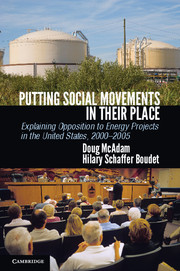 Putting Social Movements in their Place
Putting Social Movements in their Place Returning to a Copernican Approach to the Study of Contention
Published online by Cambridge University Press: 05 June 2012
Having worked our way through the main empirical findings from the research, we want to use this final chapter to do three things. We begin by revisiting the four key research questions with which we opened the book, answering each in turn based on what we have learned from our investigation. But the book was never conceived as simply a conventional research monograph. Instead, the study was motivated by a broader theoretical agenda that was reflected, as well, in our research design. Concerned that the characteristic narrowness and movement-centric focus of most scholarship in the field has seriously distorted our understanding of contentious politics, we undertook a research project that we hoped would put movements “in their place.” That is, instead of selecting successful movements for study, we chose to research communities – communities “at risk” for mobilization by virtue of their shared exposure to the “threat” of environmentally risky energy projects. Our goal was to downplay the emphasis on movements and focus on the ways that local context shapes the prospects for emergent contention, whatever form that takes. We also wanted to focus less on opposition groups and more on the broader array of actors who shape episodes of contention and stability and change in public policy. Consistent with this aim, our second goal for the chapter is to discuss our results in light of the substantial body of work on the policy process. This is all by way of urging movement scholars to take account of other literatures that clearly bear on their subject matter. Because we were simultaneously studying the dynamics of local conflict and, in the case of LNG, what we see as the emergence and consolidation of a new policy subsystem in the area of energy, it is important for us to tease out the implications of our work for this important literature. All of this is in the service of our general aim of contributing to a more Copernican understanding of contention at the expense of the Ptolemaic perspective that has come, in our view, to characterize the field. Our final goal for the chapter, then, is to use what we see as the important implications of our research to call for a significant reorientation and broadening of the field of social movement studies.
To save this book to your Kindle, first ensure [email protected] is added to your Approved Personal Document E-mail List under your Personal Document Settings on the Manage Your Content and Devices page of your Amazon account. Then enter the ‘name’ part of your Kindle email address below. Find out more about saving to your Kindle.
Note you can select to save to either the @free.kindle.com or @kindle.com variations. ‘@free.kindle.com’ emails are free but can only be saved to your device when it is connected to wi-fi. ‘@kindle.com’ emails can be delivered even when you are not connected to wi-fi, but note that service fees apply.
Find out more about the Kindle Personal Document Service.
To save content items to your account, please confirm that you agree to abide by our usage policies. If this is the first time you use this feature, you will be asked to authorise Cambridge Core to connect with your account. Find out more about saving content to Dropbox.
To save content items to your account, please confirm that you agree to abide by our usage policies. If this is the first time you use this feature, you will be asked to authorise Cambridge Core to connect with your account. Find out more about saving content to Google Drive.